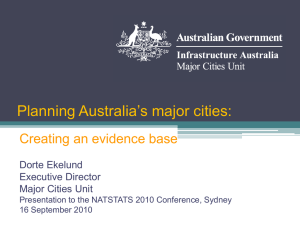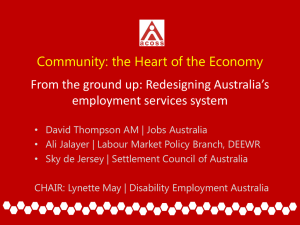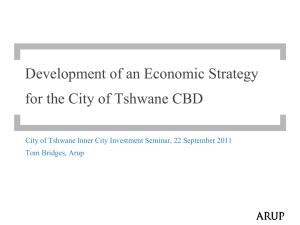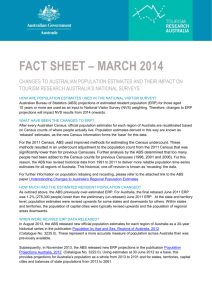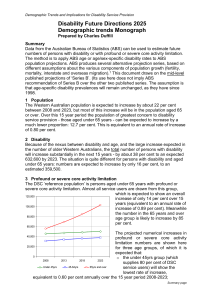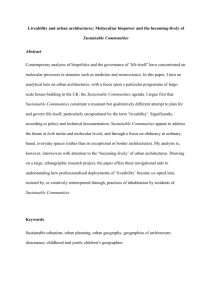Drivers for regional socioeconomic data
advertisement
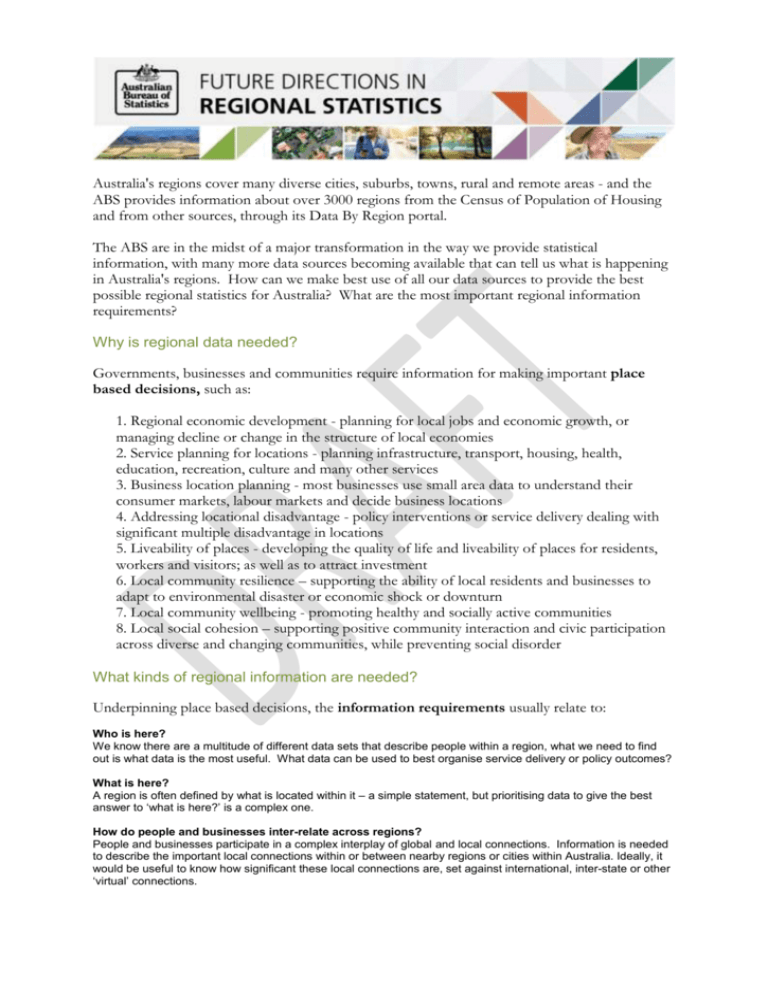
Australia's regions cover many diverse cities, suburbs, towns, rural and remote areas - and the ABS provides information about over 3000 regions from the Census of Population of Housing and from other sources, through its Data By Region portal. The ABS are in the midst of a major transformation in the way we provide statistical information, with many more data sources becoming available that can tell us what is happening in Australia's regions. How can we make best use of all our data sources to provide the best possible regional statistics for Australia? What are the most important regional information requirements? Why is regional data needed? Governments, businesses and communities require information for making important place based decisions, such as: 1. Regional economic development - planning for local jobs and economic growth, or managing decline or change in the structure of local economies 2. Service planning for locations - planning infrastructure, transport, housing, health, education, recreation, culture and many other services 3. Business location planning - most businesses use small area data to understand their consumer markets, labour markets and decide business locations 4. Addressing locational disadvantage - policy interventions or service delivery dealing with significant multiple disadvantage in locations 5. Liveability of places - developing the quality of life and liveability of places for residents, workers and visitors; as well as to attract investment 6. Local community resilience – supporting the ability of local residents and businesses to adapt to environmental disaster or economic shock or downturn 7. Local community wellbeing - promoting healthy and socially active communities 8. Local social cohesion – supporting positive community interaction and civic participation across diverse and changing communities, while preventing social disorder What kinds of regional information are needed? Underpinning place based decisions, the information requirements usually relate to: Who is here? We know there are a multitude of different data sets that describe people within a region, what we need to find out is what data is the most useful. What data can be used to best organise service delivery or policy outcomes? What is here? A region is often defined by what is located within it – a simple statement, but prioritising data to give the best answer to ‘what is here?’ is a complex one. How do people and businesses inter-relate across regions? People and businesses participate in a complex interplay of global and local connections. Information is needed to describe the important local connections within or between nearby regions or cities within Australia. Ideally, it would be useful to know how significant these local connections are, set against international, inter-state or other ‘virtual’ connections. What value or benefit do people or businesses derive from places? Many people and businesses gravitate towards regions that best fit their needs or wants. Why do people live where they live? Why do businesses locate themselves where they are? What are the push and pull factors that drive people's decisions about place? What will this place be like in the future? Having an understanding of how a region is changing is often a fundamental requirement for the people living in it and the organisations that service it. Governments, businesses and communities cannot simply plan for the ‘now’, they need reliable and cost-efficient projections for planning purposes to assist in the correct allocation of finite resources. Who is here? It is a fundamental requirement to understand the size of a region’s population and the characteristics of the people who live or work there. We know there are a multitude of different datasets that describe people and their activities within a region. What population characteristics are the most useful to understand? And why? Resident population The resident population is clearly vital information for understanding who lives in a region. Basic demographics details provided with population counts include an age/sex breakdown, number of births and number of deaths. Aboriginal and Torres Strait Islander peoples Communities need to understand the characteristics of their local Aboriginal and Torres Strait Islander populations, in order to build healthy cohesive communities and progress Australia’s reconciliation aims. Information about population counts, by age/ sex are important, along with many other characteristics listed here – including labour force characteristics, health and education outcomes. Labour Force Information about the employment characteristics of people who live or work in a region is important for service delivery, program and policy evaluation and for understanding a region's economy. Labour force data include - the size of the labour force, the unemployment rate, total employment (and participation rate), under or over-employment, type of occupation and industry of employment. Other issues that are of interest are the age of the workforce, hours of work and working conditions. Health Health is an important aspect of a person's wellbeing, and spending on health is also one of the largest government expenditures. Regional health data can include indicators such as prevalence of health conditions and disability in the population. Information is needed about how health services are being accessed and where from (i.e. locally or through travel to other regions or cities). There is also interest in health risk factors such as the level of physical activity, diet, smoking prevalence and other data items that assist in building up the health profile of people in a region. Skills and Education Education and training can not only benefit the individual, but a skilled workforce may open up opportunities for businesses and communities to leverage such skills. Relevant data may include the number of people enrolled in study, the number of graduates, the types of courses or degrees completed and the method of delivery. Information about the “skills” of a population are harder to measure compared to education qualifications, but are also relevant. It should be remembered that skills are often acquired through work rather than through training and the skills or talents of the people who live in a place are an important resource for communities. Community Diversity Understanding the cultural backgrounds of the people in a region is important for a region’s sense of identity and cohesion, as well as for developing services and businesses that can benefit from the skills and values contributed by people from diverse cultures. Information requirements include: country of birth of persons, country of birth of parents, ancestry, English as a second language, languages spoken, migrants, visa status and religion. What is here? A region is often defined by what is located within it – a simple statement but prioritising data to give the best answer to ‘what is here?’ can be complex. Infrastructure Data regarding new town/city developments, transport projects and local amenities continue to be highlighted by regional data users as being useful for decision making and analysis. Key “public” infrastructure includes most roads, ports, railways, airports, recreation parks, community facilities, walking trails, footpaths, water and power assets, drainage assets, etc. While infrastructure are the facilities and physical structures within a region, understanding the use of these items and where there is a shortage or excess capacity is also important for policy makers to understand. Housing Shelter is a basic human need, however housing data and its use is anything but basic. Data about housing can include the type of stock, the levels of development or demolition, the spread of suburbs and change in density. Ownership structures such as owner-occupier, investor or renter all add to the value of housing analysis. Information about residential occupancy rates and over-crowding are of interest and of particular note is the growing interest in housing affordability. Businesses One of the most important influences on a region's economy is the economic health of businesses operating within the region. A suite of regional business data could include indicators such as counts of businesses (by industry), and their churn (business entries, business exits and business numbers), turnover, total profit and total employment by businesses within a region. Going further, data around entrepreneurial activity, the type and amount of innovation that businesses are undertaking and their ability to adapt are also being sought. Land Use A region is often defined by the predominant uses of the land where it is situated. The type of land use will dictate the service delivery and activities that happen within that region. Land use is more than just knowing if land is residential, commercial, industrial or agricultural - regional data users are demanding finer details of land use data for planning and projections such as developments and environmental issues. Land value is also useful data in economic analyses for regions. Service Access The accessibility of services is a significant issue for many Australians. Regional data users have a need to understand the types of services available, the distance people are from services and the ease with which they can be accessed. How do people and businesses inter-relate across regions? People and businesses participate in a complex interplay of global and local connections. Information is needed to describe the important local connections within or between nearby regions or cities within Australia. Ideally, it would be useful to know how significant these local connections are, set against international, inter-state or other ‘virtual’ connections. Population Flows There is a high level of interest in the movements of people into and out of various regions (however defined), and these may be permanent moves (change of residential address) or temporary moves (visitors, tourists, shoppers, workers, etc.). This is an important consideration for program, policy and service delivery. For example, within cities there is interest in temporary moves of daily commuters, whereas in many towns and coastal areas, seasonal tourist populations are of interest. Long distance commuters (such as fly-in fly-out workers) are another kind of population flow that is of interest. Service catchments Almost universally regions do not function without external interaction with other regions. Many regions develop symbiotic infrastructure and skills sets, for example a region may have health facilities that service surrounding regions. Other regions may have businesses that serve as workplaces or as a retail hub for the residents of other regions. Understanding the relationship between regions is vital in understanding how they operate, what they contribute and what they are missing. Business Supply Chains Regions are seldom entirely self-sufficient, they rely on external inputs to be able to function. Likewise, businesses in regions consume goods and services from other regions, as part of their process of production. An efficient business supply chain can be the difference between flourishing or shrinking business activity within many regions. Most regional information about supply chains exist as local anecdotal intelligence and it is not clear, yet, how data may assist. Transport Corridors Transport corridors are typically defined by major roads, rail, ports and/or airports where large movements of often large numbers of people occur. There is interest in identifying the major transport corridors and gathering data on their use. Public Transport Public transport continues to be a topic that has strong community interest, as it supports commuters, students, elderly and others in cities and regional centres. Transport service providers are progressively gaining better data about their own customers which assists with service planning and delivery. There is potentially a wealth of data about public transport that could be useful for a coordinated approach to planning and delivery of public transport services. What value or benefit do people or businesses derive from places? Many people and businesses seem to gravitate towards regions that best fit their needs or wants. Why do people live where they live? Why do businesses locate themselves where they are? A common analysis looks at how people or businesses cluster together and why? Socio-economic advantage and disadvantage It is well established that some places have greater prevalence of advantage or disadvantage when compared to other places. The ABS produces a measure of relative advantage and disadvantage, based on Census information which is widely used. What is it about a place or the people who live there that determines the levels of advantage or disadvantage? Gaining an understanding of how people in places are “disadvantaged” can assist in developing local interventions to improve their circumstances. Social Cohesion A large aspect of an individual’s quality of life involves the ways in which that individual is able to be supported and integrated into the community they live in. What do we need to know to measure social cohesion? Some relevant indicators have been developed in surveys, such as the Scanlon Report, and the ABS General Social Survey. Questions we can ask are how often do people connect socially, with family, friends or the community, in a place? What benefits do people gain from these local connections? How do communities group together in a location to support each other and generate cohesive communities? Where are the issues within communities that are showing signs of a lack of cohesion and how can this be addressed? Social Participation and Volunteering Volunteering is seen as a positive contribution to the community. Volunteering at a regional level can have profound positive effects on that region. Volunteers can contribute to the amenity and liveability of a place and can assist regions to recover from natural disaster or economic shock. Information about volunteering is currently collected on the Census of Population and Housing, and on the General Social Survey. Business output Users have consistently asked about aggregate measures of economic activity in a region, which may be assessed by estimating Gross Regional Product. The ability to compare the size of a region’s economy and its growth or decline is seen as useful information for many stakeholders. Measuring an economy can be complex and imprecise and is particularly challenging for regions which are highly interdependent. What information is needed to improve estimates of GRP, if these are required? What region scale should be used to output meaningful estimates of GRP? Business Innovation In a rapidly changing global economy, often the ability of a business to thrive is linked to their ability to innovate. What innovation catalysts does the region provide to its businesses? What innovation is being undertaken by businesses? What investment do local businesses make in research and development activity? Income and Wealth The aggregate income and wealth of people can be used as an important local economic indicator for the region as a whole, as well as being an indicator of the economic wellbeing of the population. Wealthy communities can contribute more to a place in terms of consumption, compared to poorer communities. Higher wealth and income regions will be attractive to certain businesses, whereas some businesses or service delivery agencies may need to target people from lower socio-economic regions. Therefore data about the income and wealth of a region can be very useful for a variety of sectors. Amenity and Liveability There are a number of liveability indicators (as shown in the Department of Infrastructure & Regional Development – Chapter 5 State of the Cities Report) that are used to assess how “liveable” places are, or how places provide for the quality of life for the population that live there. Some examples include: How useful are these in terms of the data they use and what they measure? What will this place be like in future? Understanding where a region is heading is often fundamental to the people living in it and the organisations that service them. Governments, businesses and communities cannot simply plan for the ‘now’. They need reliable projections for planning purposes to assist in the correct allocation of finite resources into the future. Decisions about where to locate services or infrastructure must anticipate future needs, as well as address current needs. What regional information is needed to support the modelling of future economic and social circumstances? Predicting the future is not just a job for statisticians with predictive models. Local knowledge is absolutely vital to developing a clear understanding of what the likely future “scenarios” are for the future of a place. The local intelligence of people and businesses operating in the area may be the most important data that is needed for developing future projections. Demographic Projections A population projection can be done as a straight line prediction based on assumptions derived from historical data. However, the most difficult component to predict in population projections is the “migration” component. At a regional scale, inter-regional population movements are more volatile and subject to many factors operating at the local level (e.g. change in the economy, or change in the environment). Many regional data users also need to know how the characteristics of a population might change to best address service delivery for residents and to understand the challenges and opportunities open to the region. Economic Projections What businesses are likely to grow or decline in a place in the future? How are businesses planning to change their activity or products? What innovation is occurring in a region? Trying to understand the future economic scenarios for a region is a challenging task that requires extensive local knowledge as well as historical data. However, business surveys can ask relevant questions about how businesses are planning to innovate, and about their planned developments.




